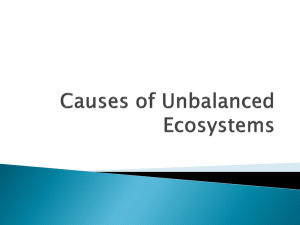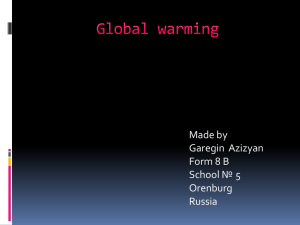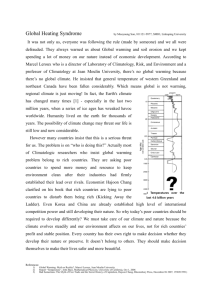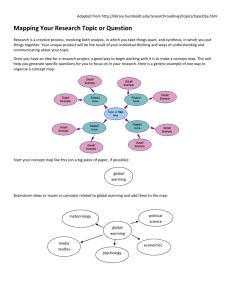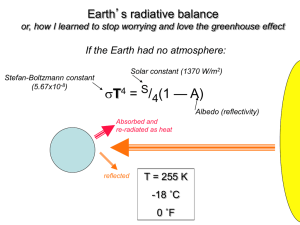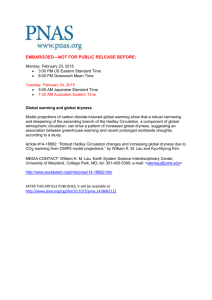Clare Roth - cynthiaahmed
advertisement
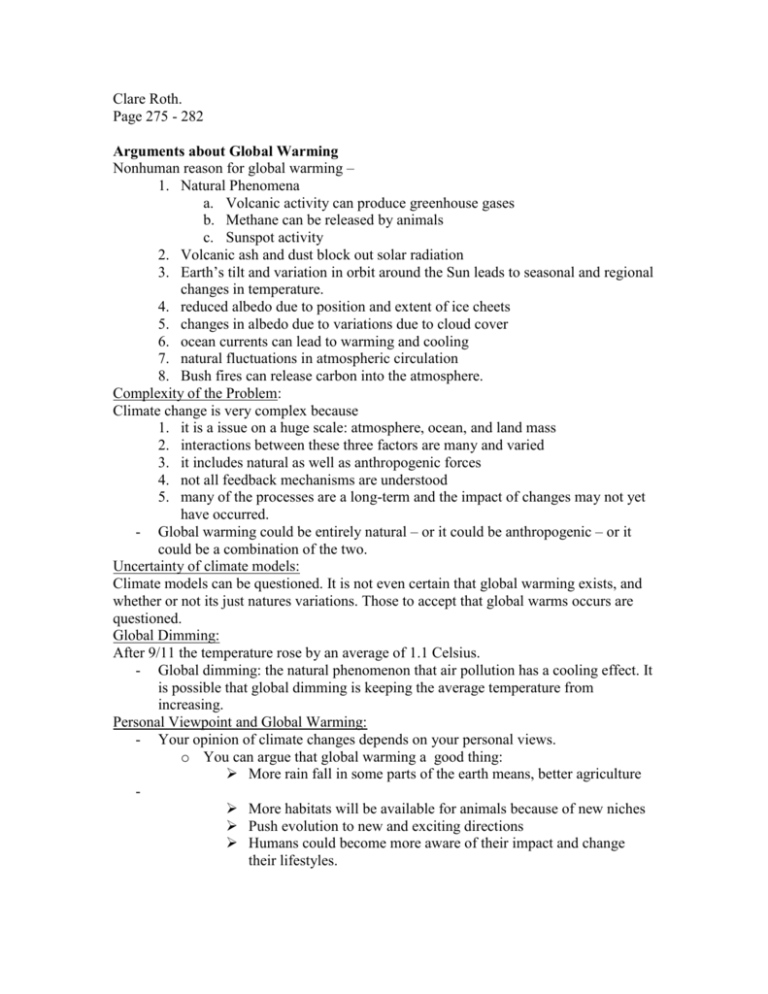
Clare Roth. Page 275 - 282 Arguments about Global Warming Nonhuman reason for global warming – 1. Natural Phenomena a. Volcanic activity can produce greenhouse gases b. Methane can be released by animals c. Sunspot activity 2. Volcanic ash and dust block out solar radiation 3. Earth’s tilt and variation in orbit around the Sun leads to seasonal and regional changes in temperature. 4. reduced albedo due to position and extent of ice cheets 5. changes in albedo due to variations due to cloud cover 6. ocean currents can lead to warming and cooling 7. natural fluctuations in atmospheric circulation 8. Bush fires can release carbon into the atmosphere. Complexity of the Problem: Climate change is very complex because 1. it is a issue on a huge scale: atmosphere, ocean, and land mass 2. interactions between these three factors are many and varied 3. it includes natural as well as anthropogenic forces 4. not all feedback mechanisms are understood 5. many of the processes are a long-term and the impact of changes may not yet have occurred. - Global warming could be entirely natural – or it could be anthropogenic – or it could be a combination of the two. Uncertainty of climate models: Climate models can be questioned. It is not even certain that global warming exists, and whether or not its just natures variations. Those to accept that global warms occurs are questioned. Global Dimming: After 9/11 the temperature rose by an average of 1.1 Celsius. - Global dimming: the natural phenomenon that air pollution has a cooling effect. It is possible that global dimming is keeping the average temperature from increasing. Personal Viewpoint and Global Warming: - Your opinion of climate changes depends on your personal views. o You can argue that global warming a good thing: More rain fall in some parts of the earth means, better agriculture More habitats will be available for animals because of new niches Push evolution to new and exciting directions Humans could become more aware of their impact and change their lifestyles. Economic benefits from better productivity because there is more carbon Trade could expand because more routes would open because polar ice caps would melt Most tourist areas could open up and more resources o Views are influenced by paradigms Paradigms are models or templates based on evidence or experience. They come from cultural and ethical standpoints Contrasting perceptions of Global warming – Al Gore, An Inconvenient Truth Al Gore won the noble peace prize For efforts to build up and disseminate greater knowledge about man-made climate change and to lay the foundations for the measures that are needed to counteract such change. Bjorn Lomborg, the Sceptical Environmentalist The sceptical Environmental: measuring the real state of the world argues that the environmental problems such as overpopulations, global warming, and biodiversity loss has no statistical analysis and says that they are general because of poverty. He agrees that global temperature increase can be related to human activity, but there are a number of uncertainties. Martin Durkin, The great global warming swindle It is a documentary that argues against the consensus scientific view that global warming is likely to be due to and increase in anthropogenic emissions of greenhouse gases. He does not think global warming is a scam. Stern Reports Reports by Nicolas Stern analyzing financial implications of climate change. It would be cheaper to address the problem than to deal with the consequences. Some of his main points are floods, diseases, storms, and water shortage will become more frequent. The poorest countries will suffer the most. Temperature rise will transform the physical geography of the planet and the way humans live. Chapter 7 Page 283-297 7.1 Environmental value systems and philosophies Definitions Environmental value systems (EVS) is a particular worldwide spread or set of paradigms that shapes the way of individuals, or group of people, perceive and evaluate environmental issues. Ones EVS is shaped by cultural background, economic and socio-political context. EVS inputs are: 1. education 2. cultural influences 3. religious texts and doctrines 4. the media EVS outputs are: 1. perspectives 2. decisions on how to act regarding environmental issues 3. Course of action EVS is divided into technocentrists and ecocentrists with anthropocentrisms in the middle. Technocentrists believe that technology with keep pace with and provide solutions to environmental problems. They approach is sometimes termed a cornucopian view: a belief in the unending resourcefulness of humans and their ability to control their environment, leading to an optimistic view about the state of the world. Ecocentrists are natural-centre and distrust modern large-scale technology; they prefer to work with natural environmental systems t solve problems, and to d this before problems get out of control. They see themselves as a subject to nature rather than the control of it. The see a world with limited resources growth needs to be controlled to that only beneficial forms occur. Anthropocentrists include both technocentric and ecocentric viewpoints. This is human centered worldview that spans the range of the environmental value system. Biocentric is a view taken by a deep ecology movement holds that all species have an intrinsic value and that humans are no more important than the other species. \ Holism is the idea that a system cannot be understood just by looking at its components; it is necessary to look at their interrelationships and the functioning as a while. This philosophy is at the center of ecocentrism. Decision-making and Environmentalism Environmental challenges posed by the extensive use of fossil fuels - the cornucopian belief in the resourcefulness of humans and their ability to control their environment would lead to an technocentric solution, where science is used to find a useful alternative. - A cornucopian would say that economic systems have a vested interest in being efficient so the exisiting problems will self-correct given enough time, and that development will increase standards of living thus increasing demands for healthy environment. Approaches of resources managers to increasing demand of water resources - A technocentric would suggest that future needs can be met by technology, innovations, and the ability to use untapped reserves. They would support the transformation of saltwater to freshwater, ice burgh capture and transfer, wastewater purification, synthetic productions, and cloud seeding. - A ecocentric would highlight the overuse and missure of water. They support the idea of water conservation, recycling, and the use of water at the sustainable level. Methods for reducing acid rain -ecocentric point of view believes to reduce the use of coal and use less energy made from fossil fuels. They would reduce the heat in their home & dress accordingly. They would avoid the use of cars and encourage “reduce, reuse, and recycle.” -technocentric would argue for the use of alternative technologies and make use it leads to economic growth. Attitudes towards ecological deficit - Ecological deficit relates to the available capacity of a country (the total amount of biologically productive space in a country.) if the ecological footprint of a country exceeds the biologically productive area, then the country has a ecological deficit. - Ecocentric people see the deficit as evidence that we are not living sustainably, with economic growth as a cause of the problem. - Technocentric people stress the importance of technology for addressing the deficit, economic growth is seen as a solution to the problem. Developments to the modern environmental movement Major Landmarks: 1. 1962 Silence Spring was published by Rachel Carson. It is one of the most influential books for environmental movement. It addressed the widespread problems of pollution and pesticides. 2. Greenpeace found in the early 1970’s they developed save the whales campaign and it made the news. Now it is a big movement and now headlines around the world and set the blueprint for future environmental campaigns. 3. Chernobyl plant in Ukraine exploded. A plume of highly radio active dust was sent to the atmosphere and feell over an extensive area. The disaster resulted in the evacuation and resettlement of 336000 people. This lead to cancer and other health issues. Environmental Value Systems A society is an arbitrary group of individuals who share some common characteristics such as geographical locations, cultural background, historical timeframe, religious perspective, and value system. Case Study Judaeo-Christian and Buddhist societies: People of different religions have different view on the Environment. In Judaeo-Christian religions is one of the stewardship, where humans have a role of responsibility towards the Earth. The Genesis story suggests that God gave the planet to humans as a gift. Other biblical stories indicate that humanity should make the most of this gift as stewards. In contrast with the Buddhist approach to the environment, this sees the human being as an intrinsic part of nature, rather than steward. Buddhism is sometimes seens as an ecological philosophy (because of its worldwide rather than anything that appears in its writings, which are not explicitly environmental.) They have respect for all life. Native Americans and European Pioneers North Americans saw their environment as communal, and had a subsistence economy based on barter. Their low-impact technologies meant that they lived in harmony with the environment- something supported by their animistic religion where all things have a soul –animals, plants, rocks, ect. Communist and Capitalist Societies Communists have been criticized for their poor environmental record. For example, the buna chemical works in East Germany dumped then times more mercury into a river. East German sulfur dioxide concentrations were the highest in the world. Some people believe that the economic principles of communism inevitably lead to environmental disaster. The communistic ideals of equal distribution of resources with no profit motive meant that energy, materials, and natural resources, could be mistreated. In capitalism model is seen by some as being environmentally friendly: the free market imposes checks-and-balances to ensure sound use of resources in order to maximize profits. Personal value systems Your personal value system determines how to respond to environmental issues. People act out of hopefulness or fearfulness, if they are enthused or frustrated, motivated or unmotivated, negative or positive. Two major things influence ones personal values social influences and personal characteristics. It enables someone to appraise a situation and emotions. The knowledge someone knows about environmental issues, the greater depth ones knows the better understanding they have on the issues.
